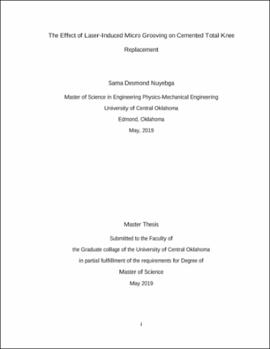| dc.contributor.author | Sama, Desmond Nuyebga | |
| dc.date.accessioned | 2021-06-23T19:30:28Z | |
| dc.date.available | 2021-06-23T19:30:28Z | |
| dc.date.issued | 2019 | |
| dc.identifier.uri | https://hdl.handle.net/11244/330081 | |
| dc.description.abstract | Total knee replacement implant surgery is at an all-time high, with 10% of Americans age 80 and older are currently living with at least one total knee replacement (TKR). An ideal implant should ensure lifelong mechanical stability with the adjoining tissues However, micromotions that occur at the implant surface activate osteoclasts, which resorb bone around the implant and contribute to implant loosening and eventual implant failure. A method to improve mechanical fixation of a TKR implant is clinically important and is the purpose of the proposed research project. This research uses a noble method that designs microgrooves on tibia tray using a laser. The goal of this study is to measure the effects of the designed microgrooves on a tibia implant that is used in dogs. The first objective of this study was to design a tibia tray for a dog by using a 3-D scanner and exporting the image into solid works. Solid works was used to design the tibia and CNC machine was used to machine the part. Six samples were made, and laser machine was used to produce laser microgrooves on three of the samples. The samples were characterized by measuring the roughness. The second objective was to design the experimental setup for use in Test Resource machine to measure the effects of grooves on the fatigue life. The third objective was to perform finite element analysis on the groove and the non-groove tibia tray and compare the results with the test result. The results were analyzed after 100000 cycles and data showed that there was a 0.017 increase in the stroke from the initial stroke to the final stroke. Using an X-ray imaging technique with a dental X-ray camera, there were some traces of cracks indicating there was a micromotion between the implant and bone. The samples with Microgrooves showed significant stability from the samples with no grooves. | en_US |
| dc.rights | All rights reserved by the author, who has granted UCO Chambers Library the non-exclusive right to share this material in its online repositories. Contact UCO Chambers Library's Digital Initiatives Working Group at diwg@uco.edu for the permission policy on the use, reproduction or distribution of this material. | |
| dc.title | The Effect of Laser-Induced Micro Grooving on Cemented Total Knee Replacement | en_US |
